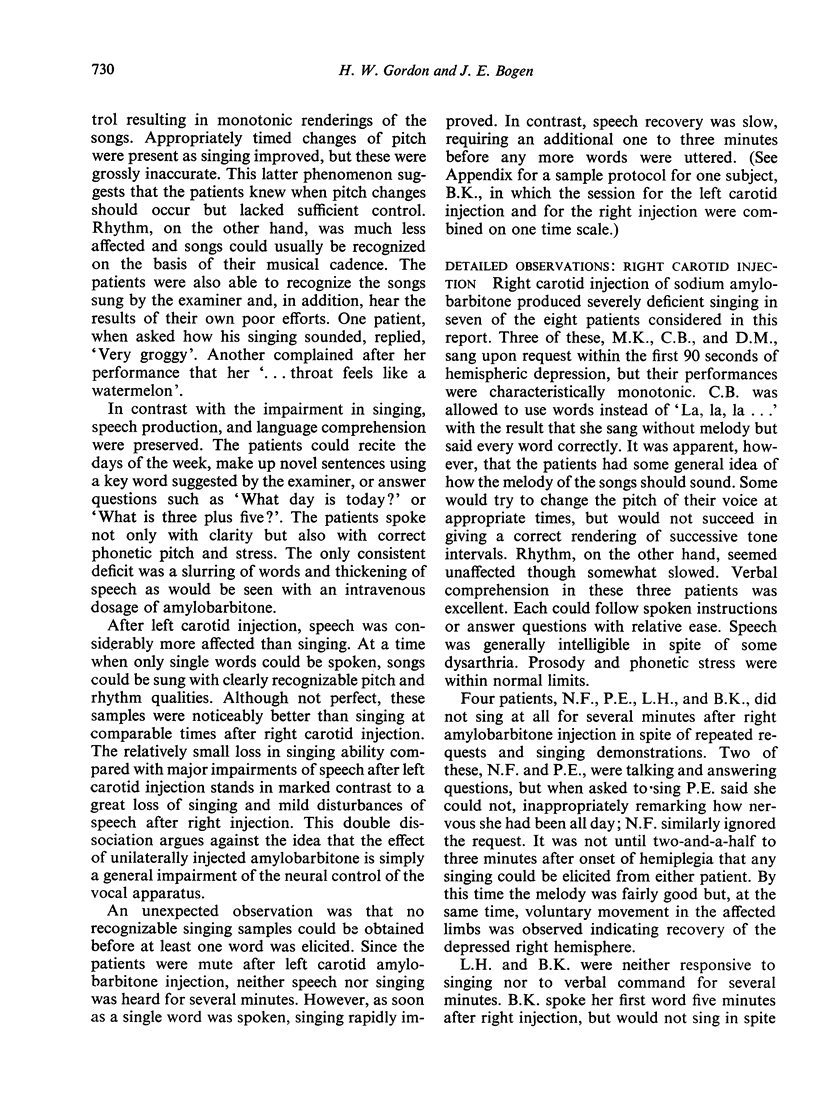Abstract
Hemispheric lateralization of singing was investigated in patients who had transient hemiplegia after intracarotid injection of sodium amylobarbitone. It was found that after right carotid injection singing was markedly deficient, whereas speech remained relatively intact. Songs were sung in a monotone, devoid of correct pitch rendering; rhythm was much less affected. By contrast, singing was less disturbed than speech after left carotid injection. The observations indicated a double dissociation; the right hemisphere contributed more for singing, whereas the left demonstrated its usual dominance for speech. A model is proposed that encompasses audible stimuli as well as tactual or visual into a scheme of functional lateralization wherein the right hemisphere specializes in processing a complete, time-independent stimulus configuration and the left in a series of successive, time-dependent units.
Full text
PDF











Selected References
These references are in PubMed. This may not be the complete list of references from this article.
- BOTEZ M. I., WERTHEIM N. Expressive aphasia and amusia following right frontal lesion in a right-handed man. Brain. 1959 Jun;82:186–202. doi: 10.1093/brain/82.2.186. [DOI] [PubMed] [Google Scholar]
- BRANCH C., MILNER B., RASMUSSEN T. INTRACAROTID SODIUM AMYTAL FOR THE LATERALIZATION OF CEREBRAL SPEECH DOMINANCE; OBSERVATIONS IN 123 PATIENTS. J Neurosurg. 1964 May;21:399–405. doi: 10.3171/jns.1964.21.5.0399. [DOI] [PubMed] [Google Scholar]
- Bogen J. E., Gordon H. W. Musical tests for functional lateralization with intracarotid amobarbital. Nature. 1971 Apr 23;230(5295):524–525. doi: 10.1038/230524a0. [DOI] [PubMed] [Google Scholar]
- Bogen J. E. The other side of the brain. I. Dysgraphia and dyscopia following cerebral commissurotomy. Bull Los Angeles Neurol Soc. 1969 Apr;34(2):73–105. [PubMed] [Google Scholar]
- Bogen J. E. The other side of the brain. II. An appositional mind. Bull Los Angeles Neurol Soc. 1969 Jul;34(3):135–162. [PubMed] [Google Scholar]
- Gordon H. W. Hemispheric asymmetries in the perception of musical chords. Cortex. 1970 Dec;6(4):387–398. doi: 10.1016/s0010-9452(70)80003-x. [DOI] [PubMed] [Google Scholar]
- JELLINEK A. Amusia; on the phenomenology and investigation of central disorders of the musical functions. Folia Phoniatr (Basel) 1956;8(3):124–149. [PubMed] [Google Scholar]
- Levy J., Trevarthen C., Sperry R. W. Reception of bilateral chimeric figures following hemispheric deconnexion. Brain. 1972;95(1):61–78. doi: 10.1093/brain/95.1.61. [DOI] [PubMed] [Google Scholar]
- Luria A. R., Tsvetkova L. S., Futer D. S. Aphasia in a composer (V. G. Shebalin). J Neurol Sci. 1965 May-Jun;2(3):288–292. doi: 10.1016/0022-510x(65)90113-9. [DOI] [PubMed] [Google Scholar]
- Milner B. Interhemispheric differences in the localization of psychological processes in man. Br Med Bull. 1971 Sep;27(3):272–277. doi: 10.1093/oxfordjournals.bmb.a070866. [DOI] [PubMed] [Google Scholar]
- SPREEN O., BENTON A. L., FINCHAM R. W. AUDITORY AGNOSIA WITHOUT APHASIA. Arch Neurol. 1965 Jul;13:84–92. doi: 10.1001/archneur.1965.00470010088012. [DOI] [PubMed] [Google Scholar]
- Smith A., Burklund C. W. Dominant hemispherectomy: preliminary report on neuropsychological sequelae. Science. 1966 Sep 9;153(3741):1280–1282. doi: 10.1126/science.153.3741.1280. [DOI] [PubMed] [Google Scholar]


